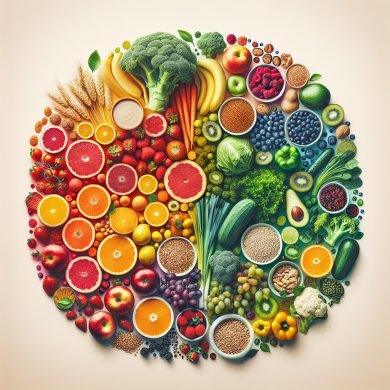Debunking Myths: Truths About Clean Eating
Introduction to Clean Eating
Clean eating is a modern nutritional trend that has gained popularity over recent decades. It emphasizes the consumption of whole, minimally processed foods and aims to maximize health benefits. However, with its rise, various myths and misconceptions have emerged, often creating confusion about what clean eating truly entails. This article will explore and debunk some common myths associated with clean eating, providing a clearer understanding of this dietary approach.
Myth 1: Clean Eating is Just Another Fad Diet
One of the most pervasive myths is that clean eating is merely a fad diet. Contrary to this belief, clean eating is not a restrictive or short-term diet plan. Instead, it is a long-term lifestyle choice that encourages eating whole foods, such as fruits, vegetables, lean proteins, and whole grains, while avoiding highly processed foods. Unlike fad diets, clean eating does not prescribe specific meal plans or calorie restrictions but promotes a sustainable and balanced way of eating.
Myth 2: All Processed Foods are Unhealthy
Another common misconception is that all processed foods are detrimental to health. The term “processed” simply means that a food item has been altered from its original form, which can include anything from washing and cutting to cooking and freezing. Not all processed foods are unhealthy. For instance, frozen vegetables and canned beans are processed but can be part of a clean eating diet. It’s essential to differentiate between minimally processed foods and highly processed ones laden with additives, preservatives, and unhealthy fats.
Myth 3: Clean Eating is Expensive
Many people believe that clean eating is costly and unaffordable for the average person. While it is true that organic produce and specialty health foods can be expensive, clean eating does not require these items. By focusing on seasonal produce, buying in bulk, and choosing affordable whole foods like legumes, grains, and seasonal fruits and vegetables, clean eating can be budget-friendly. Planning meals and reducing food waste can further help manage costs.
Myth 4: Carbohydrates Must be Eliminated
Some people assume that clean eating means cutting out carbohydrates entirely. This is a myth. Carbohydrates are an essential macronutrient and a primary energy source for the body. Clean eating encourages the consumption of complex carbohydrates, such as brown rice, quinoa, oats, and whole grain bread, rather than refined carbohydrates found in white bread and sugary snacks. These complex carbohydrates provide fiber, vitamins, and minerals essential for overall health.
Myth 5: Clean Eating is Synonymous with Organic Eating
While organic foods are often associated with clean eating, they are not synonymous. Clean eating focuses on the nutritional value and processing level of foods rather than their organic status. Non-organic foods can be part of a clean diet as long as they are whole and minimally processed. It’s more important to focus on the quality and type of food than strictly adhering to organic labels.
Myth 6: Clean Eating Guarantees Weight Loss
Another misconception is that clean eating automatically leads to weight loss. While clean eating can contribute to weight management, it is not a guaranteed weight loss solution. Weight loss depends on various factors, including caloric intake, physical activity, and individual metabolism. Clean eating supports a healthy lifestyle, but achieving weight loss requires a comprehensive approach, including regular exercise and mindful eating habits.
Myth 7: Clean Eating is Time-Consuming
Many people think that clean eating requires extensive meal preparation and cooking time. However, clean eating can be as simple or as elaborate as one desires. Quick and nutritious meals can be prepared with minimal effort using fresh ingredients and simple cooking techniques. Batch cooking, meal prepping, and using time-saving appliances like slow cookers or pressure cookers can make clean eating more convenient for those with busy schedules.
Myth 8: Clean Eating is Only for the Health-Conscious
Some individuals believe that clean eating is reserved for health enthusiasts or fitness fanatics. In reality, clean eating is suitable for anyone who wants to improve their diet and overall health. It is a flexible approach that can be adapted to fit various lifestyles and dietary needs, making it accessible to people of all ages and backgrounds. Clean eating promotes better health, increased energy levels, and improved wellbeing, making it beneficial for everyone.
Myth 9: You Must Avoid All Fats
There is a misconception that clean eating requires eliminating all fats from the diet. In truth, healthy fats are an essential part of a balanced diet. Clean eating encourages the consumption of healthy fats found in foods like avocados, nuts, seeds, and olive oil, which provide essential fatty acids and support heart health. The focus should be on avoiding trans fats and excessive saturated fats found in fried and highly processed foods.
Myth 10: Clean Eating is a One-Size-Fits-All Approach
Finally, it’s important to note that clean eating is not a rigid or one-size-fits-all approach. It can be personalized to suit individual preferences, dietary restrictions, and health goals. Clean eating is about making informed choices and prioritizing whole foods, but it allows for flexibility and personal interpretation. Everyone’s dietary needs are different, and clean eating can be adapted to accommodate various lifestyles and tastes.
Conclusion: Embracing the Truth About Clean Eating
Clean eating is a holistic approach to nutrition that emphasizes whole, minimally processed foods for better health and wellbeing. By debunking these common myths, individuals can gain a clearer understanding of what clean eating truly entails and make informed dietary choices. Clean eating is not about strict rules or deprivation, but rather about nourishing the body with wholesome foods that support a healthy and balanced lifestyle. By embracing the truths about clean eating, individuals can enjoy the benefits of improved health, vitality, and overall wellness.















Add comment